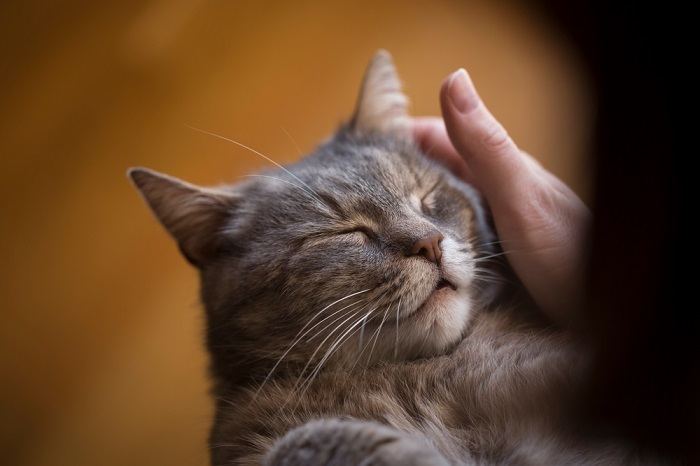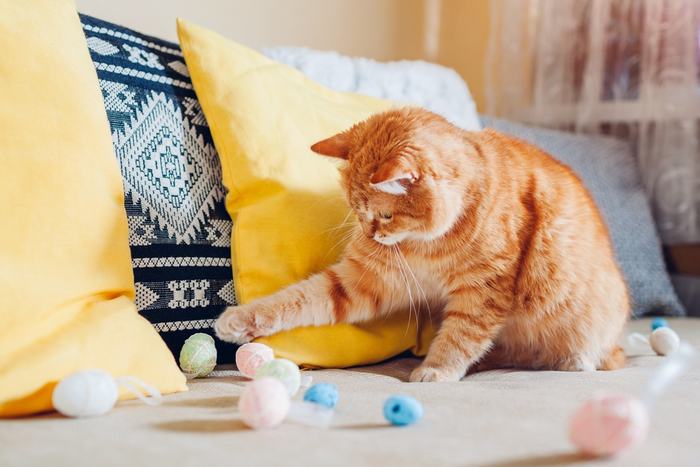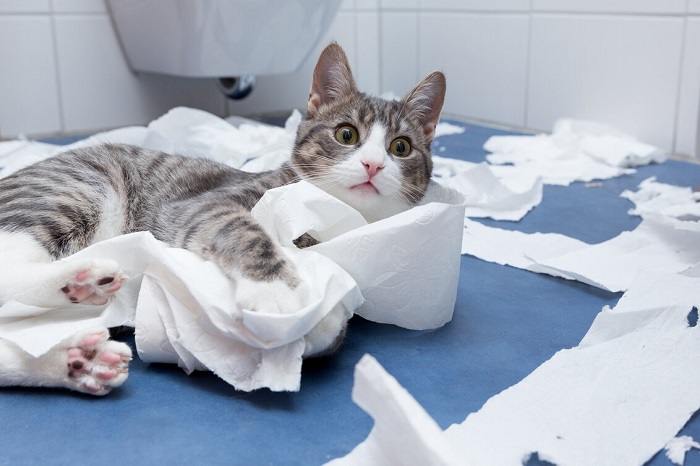
We love our cats in many ways, and for many reasons, and this includes their individual – and often mischievous! – personalities. Cats can vary in character: shy, playful, cuddly, independent and so many more. Some are highly mischievous, which can lead to some undesirable behaviors.
The good news is that you don’t have to tolerate these bad behaviors in your pet, but can still maintain a respectful and loving bond with your kitty.
Discipline can be a tricky subject, but there are lots of different methods you can try to get your cat’s attention, suitable whether you have adult cats or a kitten. Cats are all very different, so you may have to try a few scenarios before you discover what works best for your family.
The Best Ways To Discipline A Cat
Here are some of the best ways to teach your cat the do’s and don’ts of good behavior.
1. Positive Reinforcement

Using rewards when your cat does something you want them to do make her likely to repeat these good behaviors and less of the unwanted behaviors.
Cats don’t always understand the context of punishment, but they can easily link praise and treats to good behaviors that you want them to repeat.
Using rewards when your cat does something you want them to do, such as using their scratching post instead of your sofa or playing with their cat toys rather than the curtains, means they are more likely to repeat these good behaviors and therefore do less of the unwanted behaviors.
The reinforcements (treat or praise) must be given immediately as your cat does the right thing so that their brain correctly links behavior to reward.
Also Read: 11 Tips To Train Your Cat To Sleep All Night
2. Remove Your Attention

Removing yourself from giving your cat time and attention can be very effective
Discipline doesn’t always involve active measures of punishment. Removing yourself from giving your cat time and attention can be very effective at teaching a lesson about undesirable behavior.
If your cat starts being naughty, for example getting over-excited during a game with you and starts to bite or use their claws, stop the play time immediately and leave the room. A bored cat is not a happy cat, this lesson is often very effective! This method can take some repetition to really hit home, but it is a very calm way of achieving results.
3. Teach Your Cat ‘No’

Cats are also intelligent creatures, which means they are well able to learn certain commands, and respond to our body language and actions.
We don’t often think about training cats like we do dogs, but they are intelligent creatures and can learn more than you might think. If your feline’s behaviors are sometimes not quite what you want them to be, for example, if you keep finding them scratching furniture, then being able to tell them ‘no’ immediately and decisively is a good skill. Learn more about this excellent and invaluable trick here.
4. Tweak Their Environment

These tricks must be cat-safe and not designed to punish your cat
Depending on the type of undesirable behavior you are trying to stop, you might want to make some small changes to your house to help you. Some simple and non-harmful booby traps can be very effective at preventing certain mischiefs.
A silky blanket placed onto a leather sofa will cause your cat to slide off if they try to jump on the couch. Crinkly aluminum foil on the counters will deter even the most determined kitty leaper. These tricks must be cat-safe and not designed to punish your cat physically for any exploratory behaviors they make.
5. Enrichment

Pushka’s home made puzzle feeder constructed by our very own cat behaviorist Melina
This may seem counter-productive if you’re looking to deter bad behavior rather than reward it, but adding some positive bonding and playtime can help prevent naughtiness from creeping in. Cats have a strong instinct to play, chase, and hunt, and unless this is satisfied, they may well turn to objects in your house to assuage their boredom.
If you have a kitten, this is especially important. A tired cat is much less likely to get up to mischief! Plenty of positive interactions such as play, grooming, puzzle feeders, and enrichment toys will help your cat be snoozy rather than naughty when you leave them unsupervised. Check out some marvelous suggestions for cat toys here.
Also Read: The 10 Best Cat Slow Feeders & Puzzle Feeders
6. Use Scent

Cats have a very good sense of smell and are very sensitive to scents both positive and negative. If your cat is repetitively entering an area you want to keep them away from, such as jumping up onto surfaces or making their bed on top of your towels, then different scents can act as non-harmful deterrents.
Cats generally dislike citrus scents, including citronella, so using water scented with a small amount of these scents can be successful in convincing your cat to leave them alone.
Also Read: Do Cats Have Scent Glands In Their Paws?
7. Health Concerns

Cat aggression can be due to pain or discomfort
Certain medical conditions in cats can present somewhat unusually, so any change in behavior may be cause for concern. Urinating outside the litter box can be a sign of urinary infection or bladder stones or a symptom of stress and anxiety.
Aggression can be due to pain or discomfort. If your cat exhibits a change in behavior, especially if it is sudden and unexplained, a check-up with your veterinarian may be a good idea to rule out any health problems.
What NOT To Do: Discipline Methods To Avoid

Physical punishment, such as scruffing, shaking, or pinning your cat is not only harmful but usually ineffective.
Hopefully, the above methods and tips have given you plenty to think about and try in your quest to discourage mischief and general naughtiness. There are some methods of discipline that are most definitely not recommended, so please bear these in mind when deciding on your training strategy.
1. Physical Punishment

Unwanted feline behaviors can be stressful and frustrating to live with, and often a quick fix is sought. It is always worth remembering that physical punishment, such as scruffing, shaking, or pinning your cat is not only harmful but usually ineffective.
Cats will not learn when they are anxious or hurt, and are likely only to become defensive, aggressive, or afraid in general rather than linking the punishment to the specific crime. If you feel you are getting frustrated with your cat, seek help from friends or family to take over the training, or involve and professional behaviorist for assistance.
Also Read: Why Do Cats Knock Things Off Tables? 7 Reasons Why!
2. Yelling

Along similar lines to physical punishment, yelling at your cat is unlikely to help. A stern voice and strong body language may be useful when training your cat to respond to the ‘no’ command, but shouting at them is likely just to generate fear and panic. When your cat is afraid, they will be unable to learn and will just respond instinctively with flight or fight. Remaining calm is the best option.
3. Rough Play

Cats use play to simulate natural hunting behaviors such as chasing and pouncing, but this also includes biting. Allowing a kitten to nibble your moving toes may be funny, but it is then unfair to punish that same cat when an adult for biting you when you play.
Bonding through play is to be encouraged, but you need to set clear boundaries and use appropriate toys. If the play gets rough, stop. Your cat or kitten will soon learn what is acceptable.
4. Spray Bottle

A commonly held myth is that using sprayed water can deter a cat’s behavior if they stray into doing something unacceptable. Truthfully, this may work in the short term as they will recoil from the water, but just like physical punishment, they are unlikely to learn any long-term lessons from it as they will not associate the spray with the correct action, and it will just lead to stress.
Conclusion

Cats can be prone to mischief, but naughty behaviors do not need to just be tolerated. There are plenty of options for gently teaching your cat which behaviors are unacceptable, reinforcing the correct actions, and using household tricks to discourage cheeky behavior.
Physical, verbal, or more extreme forms of punishment are unnecessary, may do harm, and will likely not be effective.
Also Read: The 7 Best Cat Treats For Training







